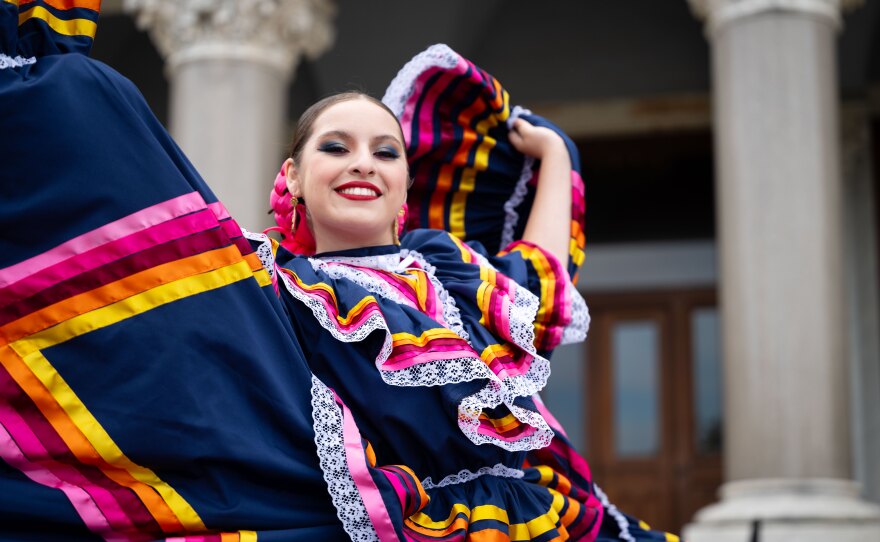‘Viva Mexico’ was shouted off the steps of the state Capitol in Hartford on Tuesday afternoon in celebration of 215 years since the first cry of Mexican Independence.
The shout is part of a longer chant known as el Grito de Dolores, the first battle cry in Mexico’s war of independence from Spain. It’s in commemoration of the Spanish priest Miguel Hidalgo, who made that first shout in the town of Dolores in Guanajuato state on Sept. 16, 1810.
It’s tradition for the president of Mexico to shout a version of el Grito from the balcony of the National Palace in Mexico City the night before Independence Day. In Connecticut, the Consulate General of Mexico in Boston, Carlos Iriarte Mercado, performed el Grito.
Tuesday marked the 10th annual celebration of Mexican Independence at the state Capitol building in Hartford. Census data estimates over 60,000 Mexicans live in Connecticut, making up the second largest Hispanic group in the state behind Puerto Ricans.
Artist Carlos Hernández Chávez, who served as Master of Ceremonies, took the opportunity to recognize the people of his community.
“It is my pleasure to recognize all workers of Mexican heritage who live in Connecticut: farm workers, laborers, nurses, educators, artists and musicians, doctors, business people, engineers, cooks, students and many others whose work and cultural heritage continue to strengthen and enrich the state's economy and cultural history,” Hernández Chávez said.
Hernández Chávez also took a moment to acknowledge the lives and shared struggles of immigrants.
“Immigrants are simply travelers in search of a better life,” he said. “We didn't come here looking for a handout or to be a burden to anyone.”
“We came to work hard and with a purpose in order to live better, more dignified lives and to build a better future for our children and our communities,” Hernández Chávez said. “We truly appreciate the hospitality the people of Connecticut have afforded us. I invite us all to celebrate and toil together in mutual trust for a freer and more peaceful existence that we all deserve.”

What it’s really like in Mexico
The Mariachi Laureles del Monte has been a staple of the state Capitol celebration of Mexican Independence Day for a few years now. Saúl Olivas, the group’s instructor, said he has adopted Connecticut as his home.
Olivas was born and raised in Las Vegas, Nevada to a Mexican family. He grew up to become a professional mariachi harpist, performing with Mariachi Mexico Antiguo. His group was invited to perform around the west coast and New England, including at the Spanish Community of Wallingford (SCOW) where they would also host workshops.
He eventually came to stay in Wallingford and continue teaching the mariachi program. Olivas has now been living in Connecticut for about 10 years.
“It's always just a great feeling of pride,” Olivas said of performing at the State Capitol for the Mexican Independence Day Celebration, “of being close to my roots, like the traditions that my parents passed on to me. I know that that's the same for my students as well.”
Teaching mariachi is not that same as it is in Las Vegas, however. Olivas said on the West Coast, mariachi music is basically built into school curriculums.
“But over here in the East Coast, it's still kind of seen as like La Cucaracha. It's like bar music, kind of in a way,” Olivas said. “So a big part of what I do like teaching here is that I get to show the students and the people that hear us that aren't used to mariachi, they get to see what it's really like, what it's like over in Mexico.”
Playing ‘a little part’ to bring out more support
Enrique Rodriguez is from the Connecticut village Amston and of Mexican descent. He was chatting with a friend after the ceremony ended.
“I was just telling him that we need to support more,” Rodriguez said. “More people should have been here.”
Around 50 people attended the event. Among them were family members of the student performers from the SCOW School of Music and Dance.
“These mariachi kids [are] amazing. The dancers, you know, I haven't seen that in 25 years,” Rodriguez said. “For me, it was a great moment.”
For Rodriguez, these kinds of events are valuable in shedding a light of authenticity on Connecticut’s Mexican American population.
“I think people need to know that we [are] united,” Rodriguez said. “We’re more than just labor or cooks or landscapers. We’re proud of our country, and even though we’re far away, I think it's great that they need to know that we are still Mexicans.”
Rodriguez said he hopes next year, there will be no empty seats and no open space on the terrace in front of the state Capitol's main portico facing Bushnell Park.
“We’re going to play our little part and spread the word and bring people here to support,” Rodriguez said. “The more people that are here, the better for the Mexican community to be heard.”









